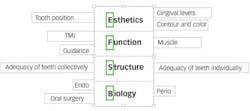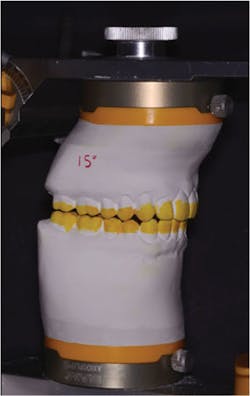Preservation of the independent dental practitioner: Increased clinical competency through continuing education
Kevin Kwiecien, DMD, MS, FAGD
In continuation of our series on the Preservation of the Independent Dental Practitioner, Dr. Kevin Kwiecien of Spear Education will discuss the impact that continuing education can have on clinical competency of a practice and our ability to diagnose and predictably treat simple to complex cases.
Many, if not most, new practitioners quickly realize that dentistry is more than taking care of teeth. It also involves practice management, as independent practice owners also serve as the CEO, CFO, COO, director of HR, and many other roles as owners of the business.
This can lead to a tough schedule of combining clinical and practice-management responsibilities. Many dentists are carrying large amounts of student debt, and with multiple responsibilities, the dentist can quickly be lured into the selling of dentistry-not the practice of dentistry. We are trained in basic clinical competency while in dental school; however, that will get us only so far. We have to be able to increase our practice and clinical competency.
One way to do this is by aligning ourselves with a proven continuing education (CE) organization that can teach us how to practice dentistry at a higher level in a predictable manner. Practitioners can achieve a sense of predictability on the clinical side by using facially generated treatment planning (FGTP). FGTP is not unique to Spear Education, but can be seen as the backbone of the Spear curriculum. The systematic, step-by-step process and the outside-in approach of using the face to determine the proper position of the teeth can have a profound, positive impact on restorative dentists, specialists, and team members alike. The benefits that this systematic process and philosophy offer clinicians are numerous: predictable treatment, reduction of daily and overall anxiety, and increased productivity and profitability, all while simultaneously resulting in more personal satisfaction for the practitioner and the team. The increase in confidence and competence resonates throughout the practice, creating an environment to work with the patient to identify appropriate steps toward health, which is very different from feeling the need and pressure to sell dentistry.
Predictable treatment
After incorporating facially generated treatment planning into practice, it quickly becomes evident that it works for every patient. This approach will help the practitioner confidently diagnose and treatment plan the simplest to the most difficult cases. Often, the cases that seem so overwhelming at first glance wind up being simple treatment plans. And conversely, using the systematic process for cases that seemed simple can reveal complexities that would have led to case failure, costly remakes, and loss of confidence on the part of the patient.
The intentional flow of patient assessment, starting with the location of the teeth in the head and face (esthetics), followed by evaluation of the joints, muscles, and occlusion (function), and then assessment of which teeth will be restored and how the process will be managed (structure), and finally assessment of which teeth will need surgery, bone augmentation, root canal therapy, extractions, etc. (biology) guides the practitioner to diagnose each category and plan accordingly. Moreover, any compromises to the ideal plan will be evident and can be rationally discussed with the patient, virtually eliminating any surprises during treatment.
Intentional flow of patient assessment guides the practitioner to diagnose each category and plan accordingly. Any compromises will be evident and can be rationally discussed with the patient, virtually eliminating any surprises during treatment.
A key component of the process is the use of photography. As such, in the three-day hands-on FGTP workshop, participants are guided through an exercise taking a full series of photographs on each other to help demonstrate the value of photography in the practice. During the course, many other cases are reviewed and treatment planned using the FGTP method. A predictable and trusted start for every case results in a predictable treatment that the practitioner can trust.
Visualizing the end before beginning-having a blueprint of the anticipated result before initiating the work-can be one of the greatest components of anxiety reduction in the dental office. Certainly, some preparatory work must be done before breaking ground, and it takes some time, yet the resulting efficiency and flow more than make up for the initial investment and effort. Mounted cases along with photography are imperative to creating an effective blueprint for completing a case. There are many articulator and photography systems. At Spear we use the SAM 3 articulators and facebow by Great Lakes Orthodontics and the Nikon D7100 photo system from PhotoMed.
A key component of the process is the use of photography (in the form of a full series) to assist in facially generated treatment planning (FGTP).
Reduce anxiety
One of the greatest benefits of a systematic approach is that it frees up the practitioner to learn with the patient. Traditionally, dentist-patient interaction starts with performing an exam, documenting the existing conditions, highlighting what is wrong, telling the patient what is broken or wrong, and explaining how it can be fixed.
The anxiety-reducing benefits of using FGTP to systematically visualize the ideal and allowing the practitioner to identify consequences to any compromises are twofold:
1. First, the practitioner can have a fact-based conversation with every patient.
a. What do I/we see?
b. What will most likely happen if nothing is done?
There are many articulator and photography systems on the market. At Spear we use the SAM 3 articulators and facebow by Great Lakes Orthodontics and the Nikon D7100 photo system from PhotoMed.
c. How can it be corrected/restored?
d. What are the benefits of treatment (outcomes from treatment, as opposed to doing nothing)?
2. Second, the doctor and patient will understand compromises to ideal treatment possibly resulting in less-than-ideal outcomes or a generalized reduction in predictability before a treatment plan is finalized.
By learning about the patient with the patient (assessing and diagnosing each of the four categories together), having a fact-based conversation, and understanding the consequences of compromise, the anxiety around traditional case presentation and treatment complications is virtually eliminated. This creates an environment where a practitioner can thrive.
The purpose of FGTP is to see the end result, the process, the options, and the compromises, so there are no surprises in the process. A calm, confident, and flowing day in the operatory is what most dentists are striving for and struggling to obtain. The consistent reduction in anxiety in the office is seen and felt by the patients and team, and reflected in the health outside of the office.
Increase productivity and profitability
Visualizing the ideal restorative outcome and understanding the compromises of less-than-ideal treatment allow the dentist to determine the most appropriate plan for every patient at that given time in life. The result is the virtual disappearance of the need to sell dentistry or even the feeling of selling dentistry.
One of several downstream outcomes is an increase in productivity. The treatment is more logical, resulting in more organized and efficient scheduling. There are also fewer no-charge "adjustment" appointments and postoperative "emergencies" to clutter the schedule and distract from other appropriately planned restorative treatment appointments as a result of the patient recognizing the value of ideal treatment. The patient is more willing to buy into and be part of the treatment plan. This has the effect of the patient being more willing to accept and pay for treatment leading to improved collections and profitability. Starting every patient with a systematic approach to treatment planning creates leverage for more logical and organized systems throughout the office flow, resulting in a more predictable bottom line.
Personal satisfaction
Facially generated treatment planning creates a platform for reliable systems in the office, consistent conversations with patients, and an office culture that supports health. The systematic and predictable system eliminates the need to sell dentistry and allows the practitioner to facilitate better oral health. If anything is being "sold," it is health, a commodity in which the majority of patients have an interest in and a desire to acquire. That said, the practitioner has the opportunity and honor to work with the patient and for the patient-not on the patient. As a result, the practitioner will develop more confidence and competence, creating momentum for an upward spiral that will feed on itself for many years of rewarding and satisfying practice. Beautiful teeth can be created with predictable function and long-lasting comfort for which patients will pay with gratitude and appreciation. Inevitably, the benefits spill over into life outside of dentistry, creating more personal satisfaction as well as financial reward in all components of life and relationships . Developing clinical competency through greater education by the practitioner results in financial success and personal satisfaction.
As resident faculty at Spear Education, Kevin Kwiecien, DMD, MS, FAGD, teaches hands-on workshops and creates and manages content for Spear Online. His 20 years of experience includes assistant professor of restorative dentistry at Oregon Health & Science University School of Dentistry as director of faculty dental practice, patient admissions, and the urgent care clinic, course director of preclinical fixed prosthodontics, and co-course director of advanced restorative concepts. Dr. Kwiecien can be reached at [email protected].



